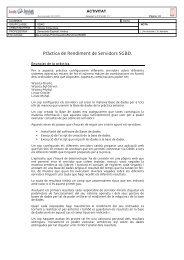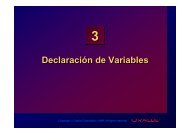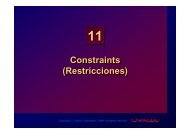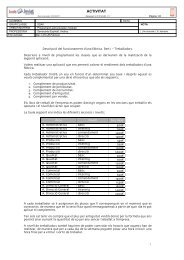Datos Agregados por medio de Funciones de Grupo
Datos Agregados por medio de Funciones de Grupo
Datos Agregados por medio de Funciones de Grupo
Create successful ePaper yourself
Turn your PDF publications into a flip-book with our unique Google optimized e-Paper software.
5<br />
<strong>Datos</strong> <strong>Agregados</strong> <strong>por</strong> <strong>medio</strong><br />
<strong>de</strong> <strong>Funciones</strong> <strong>de</strong> <strong>Grupo</strong><br />
Copyright © Oracle Cor<strong>por</strong>ation, 1998. All rights reserved.
Objetivos<br />
Al completar esta lección, <strong>de</strong>bería ser<br />
capaz <strong>de</strong> hacer lo siguiente:<br />
• I<strong>de</strong>ntificar las funciones <strong>de</strong> grupo<br />
disponibles.<br />
• Explicar el uso <strong>de</strong> las funciones <strong>de</strong><br />
grupo.<br />
• Mostrar estadísticas para diferentes<br />
grupos usando la cláusula GROUP BY.<br />
• Incluir o excluir filas agrupadas usando<br />
la cláusula HAVING.<br />
5-2 Copyright © Oracle Cor<strong>por</strong>ation, 1998. All rights reserved.
¿Qué son las <strong>Funciones</strong> <strong>de</strong> <strong>Grupo</strong><br />
Las <strong>Funciones</strong> <strong>de</strong> <strong>Grupo</strong> operan sobre conjuntos<br />
<strong>de</strong> registros para dar un resultado a nivel <strong>de</strong> grupo.<br />
EMP<br />
DEPTNO SAL<br />
--------- ---------<br />
10 2450<br />
10 5000<br />
10 1300<br />
20 800<br />
20 1100<br />
20 3000<br />
20 3000<br />
20 2975<br />
30 1600<br />
30 2850<br />
30 1250<br />
30 950<br />
30 1500<br />
30 1250<br />
“máximo salario<br />
en la tabla EMP”<br />
5-3 Copyright © Oracle Cor<strong>por</strong>ation, 1998. All rights reserved.<br />
MAX(SAL)<br />
---------<br />
5000
Tipos <strong>de</strong> <strong>Funciones</strong> <strong>de</strong> <strong>Grupo</strong><br />
• AVG ([DISTINCT|ALL]n)<br />
• COUNT ({ *|[DISTINCT|ALL]expr})<br />
• MAX ([DISTINCT|ALL]expr)<br />
• MIN ([DISTINCT|ALL]expr)<br />
• STDDEV ([DISTINCT|ALL]x)<br />
• SUM ([DISTINCT|ALL]n)<br />
• VARIANCE ([DISTINCT|ALL]x)<br />
5-4 Copyright © Oracle Cor<strong>por</strong>ation, 1998. All rights reserved.
Tipos <strong>de</strong> <strong>Funciones</strong> <strong>de</strong> <strong>Grupo</strong><br />
• AVG ([DISTINCT|ALL]n)<br />
• COUNT ({ *|[DISTINCT|ALL]expr})<br />
• MAX ([DISTINCT|ALL]expr)<br />
• MIN ([DISTINCT|ALL]expr)<br />
• STDDEV ([DISTINCT|ALL]x)<br />
• SUM ([DISTINCT|ALL]n)<br />
• VARIANCE ([DISTINCT|ALL]x)<br />
5-5 Copyright © Oracle Cor<strong>por</strong>ation, 1998. All rights reserved.
Uso <strong>de</strong> las <strong>Funciones</strong> AVG y SUM<br />
Pue<strong>de</strong> usar AVG y SUM para datos numéricos.<br />
SQL> SELECT AVG(sal), MAX(sal),<br />
2 MIN(sal), SUM(sal)<br />
3 FROM emp<br />
4 WHERE job LIKE 'SALES%';<br />
AVG(SAL) MAX(SAL) MIN(SAL) SUM(SAL)<br />
-------- --------- --------- ---------<br />
1400 1600 1250 5600<br />
5-6 Copyright © Oracle Cor<strong>por</strong>ation, 1998. All rights reserved.
Uso <strong>de</strong> las <strong>Funciones</strong> MIN y MAX<br />
Pue<strong>de</strong> usar MIN y MAX para cualquier tipo<br />
<strong>de</strong> dato.<br />
SQL> SELECT MIN(hiredate), MAX(hiredate)<br />
2 FROM emp;<br />
MIN(HIRED MAX(HIRED<br />
--------- ---------<br />
17-DEC-80 12-JAN-83<br />
5-7 Copyright © Oracle Cor<strong>por</strong>ation, 1998. All rights reserved.
Uso <strong>de</strong> la Función COUNT<br />
COUNT(*) <strong>de</strong>vuelve el nº <strong>de</strong> registros en<br />
una tabla.<br />
SQL> SELECT COUNT(*)<br />
2 FROM emp<br />
3 WHERE <strong>de</strong>ptno = 30;<br />
COUNT(*)<br />
---------<br />
6<br />
5-8 Copyright © Oracle Cor<strong>por</strong>ation, 1998. All rights reserved.
Uso <strong>de</strong> la Función COUNT<br />
COUNT(expr) <strong>de</strong>vuelve el nº <strong>de</strong> registros<br />
“no nulos” en una tabla.<br />
SQL> SELECT COUNT(comm)<br />
2 FROM emp<br />
3 WHERE <strong>de</strong>ptno = 30;<br />
COUNT(COMM)<br />
-----------<br />
4<br />
5-9 Copyright © Oracle Cor<strong>por</strong>ation, 1998. All rights reserved.
<strong>Funciones</strong> <strong>de</strong> <strong>Grupo</strong> y Val. Nulos<br />
Las <strong>Funciones</strong> <strong>de</strong> <strong>Grupo</strong> ignoran los<br />
valores nulos <strong>de</strong> las columnas.<br />
SQL> SELECT AVG(comm)<br />
2 FROM emp;<br />
AVG(COMM)<br />
---------<br />
550<br />
5-10 Copyright © Oracle Cor<strong>por</strong>ation, 1998. All rights reserved.
Uso <strong>de</strong> la Función NVL con<br />
<strong>Funciones</strong> <strong>de</strong> <strong>Grupo</strong><br />
La Función NVL fuerza a las funciones <strong>de</strong><br />
grupo a incluir valores nulos (null).<br />
SQL> SELECT AVG(NVL(comm,0))<br />
2 FROM emp;<br />
AVG(NVL(COMM,0))<br />
----------------<br />
157.14286<br />
5-11 Copyright © Oracle Cor<strong>por</strong>ation, 1998. All rights reserved.
Creando <strong>Grupo</strong>s <strong>de</strong> <strong>Datos</strong><br />
EMP<br />
DEPTNO SAL<br />
--------- ---------<br />
10 2450<br />
10 5000<br />
10 1300<br />
20 800<br />
20 1100<br />
20 3000<br />
20 3000<br />
20 2975<br />
30 1600<br />
30 2850<br />
30 1250<br />
30 950<br />
30 1500<br />
30 1250<br />
2916.6667<br />
2175<br />
“media <strong>de</strong><br />
salarios<br />
en EMP<br />
para cada<br />
<strong>de</strong>partamento”<br />
1566.6667<br />
DEPTNO AVG(SAL)<br />
------- ---------<br />
10 2916.6667<br />
20 2175<br />
30 1566.6667<br />
5-12 Copyright © Oracle Cor<strong>por</strong>ation, 1998. All rights reserved.
Creando <strong>Grupo</strong>s <strong>de</strong> <strong>Datos</strong>:<br />
La Cláusula GROUP BY<br />
SELECT column, group_function<br />
FROM<br />
table<br />
[WHERE condition]<br />
[GROUP BY group_by_expression]<br />
[ORDER BY column];<br />
Divi<strong>de</strong> los registros <strong>de</strong> una tabla en grupos<br />
más pequeños, <strong>por</strong> <strong>medio</strong> <strong>de</strong> GROUP BY.<br />
5-13 Copyright © Oracle Cor<strong>por</strong>ation, 1998. All rights reserved.
Uso <strong>de</strong> la Cláusula GROUP BY<br />
Todas las columnas mencionadas en la<br />
SELECT que no son funciones <strong>de</strong> grupo,<br />
tienen que estar en la cláusula GROUP BY.<br />
SQL> SELECT <strong>de</strong>ptno, AVG(sal)<br />
2 FROM emp<br />
3 GROUP BY <strong>de</strong>ptno;<br />
DEPTNO AVG(SAL)<br />
--------- ---------<br />
10 2916.6667<br />
20 2175<br />
30 1566.6667<br />
5-14 Copyright © Oracle Cor<strong>por</strong>ation, 1998. All rights reserved.
Uso <strong>de</strong> la Cláusula GROUP BY<br />
La columna referencia <strong>por</strong> GROUP BY no<br />
es necesario seleccionarla.<br />
SQL> SELECT AVG(sal)<br />
2 FROM emp<br />
3 GROUP BY <strong>de</strong>ptno;<br />
AVG(SAL)<br />
---------<br />
2916.6667<br />
2175<br />
1566.6667<br />
5-15 Copyright © Oracle Cor<strong>por</strong>ation, 1998. All rights reserved.
Agrupación <strong>por</strong> Más <strong>de</strong> Una Columna<br />
EMP<br />
DEPTNO JOB<br />
SAL<br />
--------- --------- ---------<br />
10 MANAGER 2450<br />
10 PRESIDENT 5000<br />
10 CLERK 1300<br />
20 CLERK 800<br />
20 CLERK 1100<br />
20 ANALYST 3000<br />
20 ANALYST 3000<br />
20 MANAGER 2975<br />
30 SALESMAN 1600<br />
30 MANAGER 2850<br />
30 SALESMAN 1250<br />
30 CLERK 950<br />
“suma <strong>de</strong> salarios<br />
<strong>de</strong> EMP para<br />
cada oficio (job),<br />
agrupado <strong>por</strong><br />
<strong>de</strong>partamento”<br />
DEPTNO<br />
--------<br />
10<br />
10<br />
10<br />
20<br />
20<br />
20<br />
30<br />
30<br />
30<br />
JOB SUM(SAL)<br />
--------- ---------<br />
CLERK 1300<br />
MANAGER 2450<br />
PRESIDENT 5000<br />
ANALYST 6000<br />
CLERK 1900<br />
MANAGER 2975<br />
CLERK 950<br />
MANAGER 2850<br />
SALESMAN 5600<br />
30 SALESMAN 1500<br />
30 SALESMAN 1250<br />
5-16 Copyright © Oracle Cor<strong>por</strong>ation, 1998. All rights reserved.
Uso <strong>de</strong> la Cláusula GROUP BY<br />
sobre Múltiples Columnas<br />
SQL> SELECT <strong>de</strong>ptno, job, sum(sal)<br />
2 FROM emp<br />
3 GROUP BY <strong>de</strong>ptno, job;<br />
DEPTNO JOB SUM(SAL)<br />
--------- --------- ---------<br />
10 CLERK 1300<br />
10 MANAGER 2450<br />
10 PRESIDENT 5000<br />
20 ANALYST 6000<br />
20 CLERK 1900<br />
...<br />
9 rows selected.<br />
5-17 Copyright © Oracle Cor<strong>por</strong>ation, 1998. All rights reserved.
Consultas No válidas<br />
Usando <strong>Funciones</strong> <strong>de</strong> <strong>Grupo</strong><br />
Cualquier columna o expresión en la<br />
SELECT que no sea una función agregada,<br />
tiene que ser especificada en la cláusula<br />
GROUP BY.<br />
SQL> SELECT <strong>de</strong>ptno, COUNT(ename)<br />
2 FROM emp;<br />
SELECT <strong>de</strong>ptno, COUNT(ename)<br />
*<br />
ERROR at line 1:<br />
ORA-00937: not a single-group group function<br />
5-18 Copyright © Oracle Cor<strong>por</strong>ation, 1998. All rights reserved.
Consultas No válidas<br />
Usando <strong>Funciones</strong> <strong>de</strong> <strong>Grupo</strong><br />
• No pue<strong>de</strong> usar una cláusula WHERE para<br />
restringir grupos.<br />
• Utilice la cláusula HAVING para restringir grupos.<br />
SQL> SELECT <strong>de</strong>ptno, AVG(sal)<br />
2 FROM emp<br />
3 WHERE AVG(sal) > 2000<br />
4 GROUP BY <strong>de</strong>ptno;<br />
WHERE AVG(sal) > 2000<br />
*<br />
ERROR at line 3:<br />
ORA-00934: group function is not allowed here<br />
5-19 Copyright © Oracle Cor<strong>por</strong>ation, 1998. All rights reserved.
Exclusión <strong>de</strong> Resultados <strong>de</strong> un <strong>Grupo</strong><br />
EMP<br />
DEPTNO<br />
SAL<br />
--------- ---------<br />
10 2450<br />
10 5000<br />
10 1300<br />
5000<br />
20 800<br />
20 1100<br />
20 3000<br />
20 3000<br />
3000<br />
“máximo salario<br />
<strong>por</strong> <strong>de</strong>partamento<br />
mayor <strong>de</strong> 2900$”<br />
DEPTNO MAX(SAL)<br />
--------- ---------<br />
10 5000<br />
20 2975<br />
20 3000<br />
30 1600<br />
30 2850<br />
30 1250<br />
30 950<br />
2850<br />
30 1500<br />
30 1250<br />
5-20 Copyright © Oracle Cor<strong>por</strong>ation, 1998. All rights reserved.
Exclusión <strong>de</strong> Resultados <strong>de</strong> un <strong>Grupo</strong>:<br />
Cláusula HAVING<br />
Use la cláusula HAVING para restringir grupos:<br />
– Los registros son agrupados.<br />
– Se aplica la función <strong>de</strong> grupo.<br />
– Los grupos que se correspon<strong>de</strong>n con la<br />
cláusula HAVING se visualizan.<br />
SELECT column, group_function<br />
FROM<br />
table<br />
[WHERE condition]<br />
[GROUP BY group_by_expression]<br />
[HAVING group_condition]<br />
[ORDER BY column];<br />
5-21 Copyright © Oracle Cor<strong>por</strong>ation, 1998. All rights reserved.
Uso <strong>de</strong> la Cláusula HAVING<br />
SQL> SELECT <strong>de</strong>ptno, max(sal)<br />
2 FROM emp<br />
3 GROUP BY <strong>de</strong>ptno<br />
4 HAVING max(sal)>2900;<br />
DEPTNO MAX(SAL)<br />
--------- ---------<br />
10 5000<br />
20 3000<br />
5-22 Copyright © Oracle Cor<strong>por</strong>ation, 1998. All rights reserved.
Uso <strong>de</strong> la Cláusula HAVING<br />
SQL> SELECT job, SUM(sal) PAYROLL<br />
2 FROM emp<br />
3 WHERE job NOT LIKE 'SALES%'<br />
3 GROUP BY job<br />
4 HAVING SUM(sal)>5000<br />
5 ORDER BY SUM(sal);<br />
JOB<br />
PAYROLL<br />
--------- ---------<br />
ANALYST 6000<br />
MANAGER 8275<br />
5-23 Copyright © Oracle Cor<strong>por</strong>ation, 1998. All rights reserved.
Anidamiento <strong>de</strong> <strong>Funciones</strong> <strong>de</strong> <strong>Grupo</strong><br />
Visualizar la máxima media <strong>de</strong> salarios <strong>por</strong><br />
<strong>de</strong>partamento:<br />
SQL> SELECT max(avg(sal))<br />
2 FROM emp<br />
3 GROUP BY <strong>de</strong>ptno;<br />
MAX(AVG(SAL))<br />
-------------<br />
2916.6667<br />
5-24 Copyright © Oracle Cor<strong>por</strong>ation, 1998. All rights reserved.
Resumen<br />
SELECT column, group_function<br />
FROM<br />
table<br />
[WHERE condition]<br />
[GROUP BY group_by_expression]<br />
[HAVING group_condition]<br />
[ORDER BY column];<br />
5-25 Copyright © Oracle Cor<strong>por</strong>ation, 1998. All rights reserved.
Visión General <strong>de</strong> la Práctica<br />
• Mostrar diferentes consultas que<br />
puedan usar todas las funciones <strong>de</strong><br />
grupo.<br />
• Agrupar las filas para obtener más <strong>de</strong><br />
un resultado.<br />
• Excluir grupos usando la cláusula<br />
HAVING.<br />
5-26 Copyright © Oracle Cor<strong>por</strong>ation, 1998. All rights reserved.
5-27 Copyright © Oracle Cor<strong>por</strong>ation, 1998. All rights reserved.











